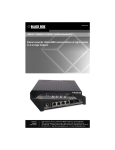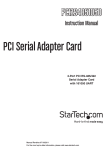Download Eddy User Guide - Trenz Electronic
Transcript
Eddy User’s Guide English Ver 1.0 May 25, 2006 Eddy User Guide Revision History Document Revision Date Version May 25, 2006 1.0 Pages Description All Initial release by jhkim Copyright 2006 SystemBase Co., Ltd. All rights reserved. Website http://www.sysbas.com/ Tel 82-2-855-0501 Fax 82-2-855-0580 16th Fl. Daerung Post Tower-1, 212-8, Guro-dong, Guro-gu, Seoul, Korea For any inquiries or comments, contact to [email protected] 2 Eddy User Guide Contents Chapter 1. Introduction 5 1. About This Document 5 2. Who Should Read This Document? 5 3. Document Structure 6 4. Eddy Documents 7 5. Technical Supports 8 Chapter 2. Getting Started 9 1. Overview 9 2. Features 11 3. Package Checklist 12 4. Applications 13 Chapter 3. Hardware Description 14 1. Eddy-1/Pin & Eddy-1/Pin Pro 14 Chapter 4. Integration 20 1. Eddy-1/Pin & Eddy-1/Pin Pro 20 Chapter 5. Configuration via Web 23 1. Connection 23 2. Setup Menu 24 3. Network Settings 25 4. Serial Settings 27 5. GPIO Settings 31 6. Admin Settings 32 3 Eddy User Guide 7. Change Password 33 8. Update Firmware 34 9. Factory Default 35 10. Save & Reboot 36 Chapter 6. Configuration via Telnet 37 1. Connection 37 2. View Commands 38 3. Network Commands 38 4. Serial Commands 40 5. GPIO Commands 43 6. Username/Password Commands 43 7. System Commands 43 Chapter 7. Appendix 44 1. Firmware Update 44 2. Technical Specifications 48 4 Eddy User Guide Chapter 1. Introduction This chapter is an introduction to SystemBase embedded device server Eddy series and this document. 1. About This Document This guide is designed for users of Eddy, who are in charge of connecting to and communicating with Eddy, setting Eddy’s configurations, status monitoring, firmware update, and other administration work. 2. Who Should Read This Document? This guide is designed for Eddy users and administrators. It is strongly recommended that anyone trying to apply, use, and maintain Eddy read this document. This guide deals with the hardware-level integration issues and software-level configuration tips. It will be a great starting point for any administrators who want to easily monitor and control Eddy and its connected devices. 5 Eddy User Guide 3. Document Structure Introduction (Chapter 1) is a preface with general information and introductory notices. Getting Started (Chapter 2) gives a brief introduction to Eddy series, including features and applications. Hardware Descriptions (Chapter 3) explains about the layout and pin specifications with block diagram and drawings. Integration (Chapter 4) helps you to connect Eddy to serial and network environment. It ends up with first time boot-up and status check. Configuration via Web (Chapter 5) provides menu-by-menu guide for setting up the operation environment for Eddy via web browser. Configuration via Telnet (Chapter 6) provides a list of commands for setting up the operation environment for Eddy via Telnet. Appendix (Chapter 7) provides firmware update guides and technical specifications for detailed information. 6 Eddy User Guide 4. Eddy Documents The following table summarizes documents included in the Eddy document set. Document Name Description User Guide Integration, configuration, and management tasks are explained for the administrator Programmer’s Guide Programmer’s application development guide, including in-depth approach to compiling, linking, and firmware/application generation API reference manual is also included with a list of available functions and structures for customized application programming (only for Eddy-1/Pin Pro) Portview User Manual Guide for SystemBase device server management application Portview COM Port Redirector User Manual Guide for SystemBase COM Port Redirector If you need brief information on Eddy or embedded device servers in general, please visit our company website at http://www.sysbas.com/. You can view and/or download documents related to Eddy as well as latest software and firmware updates. Available resources are as follows: Document Name Description Eddy Spec Sheet Specifications for Eddy products Eddy White Paper An easy reading for anyone new to embedded device server. Deals with background and technology Past, present, and future of embedded device servers along with the overview of market environment Eddy Application Notes Various applications of Eddy presented in diagrams and images All documents are updated promptly, so check for the recent document update. The contents in these documents are subject to change without any notice in advance. 7 Eddy User Guide 5. Technical Supports There are three ways you can get a technical support from SystemBase. First, visit our website http://www.sysbas.com/ and go to ‘Technical Support’ menu. There you can read FAQ and ask your own question as well. Second, you can e-mail our technical support team. The mail address is [email protected]. Any kind of inquiries, requests, and comments are welcome. Finally, you can call us at the customer center for immediate support. Our technical support team will kindly help you get over with the problem. The number to call is 82-2-855-0501 (Extension number 225). Do not forget to dial the extension number after getting a welcome message. 8 Eddy User Guide Chapter 2. Getting Started Welcome to Eddy! This chapter includes Eddy series overview, main and distinctive features, package contents for each product, and application fields. 1. Overview Eddy series consists of 2 products: Eddy-1/Pin and Eddy-1/Pin Pro. Eddy-1/Pin Pro supports programmability while Eddy-1/Pin doesn’t. Programmability 1) Programmable Description: You can program and download your own application on the module. Products: Eddy-1/Pin Pro 2) Non-programmable Description: Application built-in, plug-and-play type module Products: Eddy-1/Pin There is also Eddy-1/Pin DK, a development kit for helping programmers easily test their applications and operations of Eddy. The kit includes evaluation board, all necessary connectors, and programming environment with documentations and guidelines. 9 Eddy User Guide Selection Guide Eddy-1/Pin Eddy-1/Pin Pro CPU 32-bit ARM9 Core Flash 4MB SDRAM 8MB Serial Interface RS232/422/485 (Selectable with Pins) Serial Connector 24-Pin Header (10+14) Serial Speed Max 921.6Kbps LAN Interface 10/100Mbps Ethernet LAN Connector RJ45 with Embedded Transformer Dimensions 55 * 38 mm Weight 19g GPIO 4 Programmable I/O Pins Power Input 3.3V Power Consumption 260mA Programmable No Yes SystemBase SDK/API No Yes 10 Eddy User Guide 2. Features Various features of Eddy make it a universal yet distinctive embedded solution. Here we present main features of Eddy series. Others will explicitly appear throughout this guide. - Premium-level hardware with ARM9 168MHz CPU, 4MB Flash, and 8MB SDRAM - Pin selectable RS232/422/485 interfaces - Max 921.6Kbps serial speed - Program and run your own application (Eddy-1/Pin Pro) - SystemBase SDK and API support for application programming (Development Kit) - Small size to fit in any hardware - 10/100Mbps Ethernet port with transformer - SystemBase COM Port Redirector for better adaptability - Extensive configuration and monitoring with Portview - Firmware upload with Web, FTP, and TFTP - Configuration with Web, Telnet, SNMP, and Portview - Lots of customizing options - Standard Linux environment for openness in executable applications - 4 Programmable IO for customized applications 11 Eddy User Guide 3. Package Checklist Eddy package is composed of following components. Make sure every component is included with your package. Module All module packages include a module and a CD with utilities and documents. Eddy-1/Pin: Eddy-1/Pin module and a CD Eddy-1/Pin Pro: Eddy-1/Pin Pro module and a CD Development Kit Eddy-1/Pin Evaluation Board Board Supporters Serial Cable 1pc (null modem cable) Cross LAN Cable 1pc USB Cable 1pc (for firmware download) Power Adaptor 1pc Power Cable 1pc (Euro or US – selectable in order) CD (SystemBase SDK, compile environment, documentations, etc.) 12 Eddy User Guide 4. Applications Eddy can be applied to many practical applications in various fields. Here we present some of them. Factory / Industrial Automation PLC, Robot arms, Human-Machine Interface, Warehouse rails Medical instruments, Inspection equipment controllers Alarming units Home Appliances / Electronic Devices Power controller, Gaming machines Scales, Gas detection units, Water & pollution metering devices Data collection and distribution units Financial / Building Automation Card readers, Barcode scanners, Kiosks, Point-Of-Sale related devices Serial printers, Cash registers, Credit card authorization terminals Biometric detection units, Security devices OEM Device Server Distributors OEM device server with distributor’s own case & brand Ready-to-go device or customized application / setup mode can be inserted 13 Eddy User Guide Chapter 3. Hardware Description This chapter provides Eddy’s hardware information, including block diagram, layout, pin specifications, dimensions and other hardware-related issues. 1. Eddy-1/Pin & Eddy-1/Pin Pro Eddy-1/Pin and Eddy-1/Pin Pro have identical hardware specifications. They are only different in the software level. Picture Side View 1 Side View 2 Top View Bottom View 14 Eddy User Guide Block Diagram LED RJ45 Ethernet port has two LEDs for displaying status. Left LED: 100Mbps Link Right LED: LAN Tx 15 Eddy User Guide Pin Specifications 1) Pin Header - RS232 - RS422 J1 J1 1 DCD 2 RXD 1 3 TXD 4 DTR 3 5 GND 6 DSR 5 7 RTS 8 CTS 7 TX- 9 USBN 9 USBN 10 USBP J1 2 TX+ - RS485 RX+ 3 4 6 1 RX- 2 TRX+ 4 5 6 8 7 TRX- 8 10 USBP 9 USBN 10 USBP <Top View> J1 LAN Port J2 1 2 3 4 5 6 7 8 9 10 1 2 3 4 5 6 7 8 9 10 11 12 13 14 J2 1 INF_1 2 3.3V 3 INF_0 4 3.3V 5 TR1 6 TR0 7 RDY# 8 RST# 9 GND 10 GND 11 PIO3 12 PIO2 13 PIO1 14 PIO0 J1 Pin Description 1 DCD RS232 Signal (Data Carrier Detect) 2 RXD RS232 Signal (Receive Data) 3 TXD RS232 Signal (Transmit Data) 4 DTR RS232 Signal (Data Terminal Ready) 5 GND RS232 Signal (Signal Ground) 6 DSR RS232 Signal (Data Set Ready) 7 RTS RS232 Signal (Ready To Send) 8 CTS RS232 Signal (Clear To Send) 9 USBN USB data line for firmware upload (Only for development purpose) 10 USBP USB data line for firmware upload (Only for development purpose) RX+ RS422 Signal (Receive Data +) TX+ RS422 Signal (Transmit Data +) 16 Eddy User Guide TX- RS422 Signal (Transmit Data -) RX- RS422 Signal (Receive Data -) TRX+ RS485 Signal (Transmit/Receive Data +) TRX- RS485 Signal (Transmit/Receive Data -) J2 Pin Description 1 INF_1 Serial Interface Selector 1 2 3.3V Power In 3 INF_0 Serial Interface Selector 0 4 3.3V Power In 5 TR1 Terminal Resistor 6 TR0 Terminal Resistor 7 RDY# Ready LED Out 8 RST# External Reset In 9 GND Signal Ground 10 GND Signal Ground 11 PIO3 Programmable IO 3 (user defined) 12 PIO2 Programmable IO 2 (user defined) 13 PIO1 Programmable IO 1 (user defined) 14 PIO0 Programmable IO 0 (user defined) 2) Serial Interface Selection Since Eddy supports on-board selection of RS232 / RS422 / RS485, and each interface can be configured by a combination of INF_1, INF_0, and TR signals. INF_1 INF_0 Terminal Resistor RS232 OFF OFF OFF RS422 OFF ON USER RS485 ON OFF USER 17 Eddy User Guide 3) Terminal Resistor Terminal Resistors are installed in RS422 or RS485 communication to prevent noise and distortion of long distance data transfer. They help by matching impedance in communication line, and normally 120 ohm resistors are used. Since the use of terminal resistor is the decision of users, in Eddy series, user can either install or not install terminal resistors in RS422 or RS485 mode. Installation can be done by connecting TR0 and TR1 pin on J2 pin header to the resistor. Usual configuration for these pins is to use a jumper to connect both pins and control from one switch. Here is a guideline for installing terminal resistors. RS422 Install terminal resistors at each end (terminal). RS485 Install terminal resistors only at each end (not in the middle ones in Multi-Drop structure) 18 Eddy User Guide Dimensions Top View Bottom View 19 Eddy User Guide Chapter 4. Integration This chapter explains how you can make Eddy to communicate. It deals with LAN and pin header connection guides for Eddy to operate together with the target serial device. 1. Eddy-1/Pin & Eddy-1/Pin Pro Follow these steps to connect Eddy to the device and network. Assemble Guide 1) LAN In order to connect Eddy to network, you need to use RJ45 Ethernet port. It supports both 10Mbps and 100Mbps Ethernet connection (auto-sensing). Plug one end of a cross LAN cable to Eddy and the other end to a hub, switch, or any other network device that can provide you with network access. 2) Pin Header In order to connect Eddy to an external serial device, two pin header cables are required. One should have 10 pins, and the other should have 14 pins. Serial and power lines are included in these 24 pins. For pin specifications, please refer to Chapter 3. Hardware. Please note that not all 24 pins must be used. You can selectively connect only those pins relevant to your application. 20 Eddy User Guide First-Time Bootup If the 3.3V power (Please note that it is not 5V) has been successfully supplied from the pin header, Eddy will power on and start booting. It is a good practice to connect both pin 2 and pin 4 of J2 as power pins for better stability. Although there is no power LED to check the status, you can check by LEDs on the RJ45 Ethernet port. LED status operation is described in Chapter 3. Hardware. An IP address is required to access Eddy’s web interface or telnet command-line configuration tool. By factory default, Eddy is assigned a static IP address. After the initial connection, you can either manually assign a different IP address or set Eddy to automatically get an IP address from a DHCP server. While this depends on your network environment and policy, it is strongly recommended that you assign Eddy with a unique static IP. The factory default IP address: 192.168.0.223 Eddy’s default IP address is set to 192.168.0.223. In order to connect with this address, you need to change network configurations so that your PC can connect to the IP 192.168.0.223. Please refer to an example below, and note that values doesn’t necessarily have to be identical to the example below. 21 Eddy User Guide In case you configure Eddy to use DHCP to obtain an IP address automatically, you might find it hard to know the IP address to connect to. To provide users with an easier way to know the current IP address, Eddy has a fixed alias IP that is always accessible. Use the address below whenever you cannot find out Eddy’s IP address. Factory default alias IP address: 10.10.1.1 In order to connect with this address, you need to change network configurations so that your PC can connect to the IP 10.10.1.1. Please refer to an example below, and note that values doesn’t necessarily have to be identical to the example below. Now you are ready to connect to Eddy! There are three options to configure Eddy. Web: You can easily configure Eddy with web interface, accessible from any web browser. For more information, please refer to Chapter 5. Configuration via Web. Telnet: You can configure Eddy with commands after accessing Eddy through Telnet. For more information, please refer to Chapter 6. Configuration via Telnet. Portview: You can use a Windows-based utility Portview from SystemBase to monitor Eddy. For more information on using the utility for your administration purpose, please refer to Portview User Guide. 22 Eddy User Guide Chapter 5. Configuration via Web 1. Connection Open your favorite web browser and enter the IP address of Eddy to access Eddy’s web manager. Once you are successfully connected, the following front page will show up. You need to enter appropriate username and password to login. Please note that this username and password is used as authentication method for Telnet as well. This means if username or/and password has been modified from the web interface, modified values have to be entered to connect to Telnet, and vice versa. Factory default username: eddy Factory default password: 99999999 23 Eddy User Guide 2. Setup Menu If login process is successful, you will see a web manager’s main page, showing summary of your device. On the left, you will see a setup menu, and you can navigate through these options. Summary : View a summary of Eddy. Network Settings : Configure network connection settings. Serial Settings : Configure detailed operation environment for serial communication. GPIO Settings : Configure programmable I/O pins. Admin Settings : View and change device information and support information. Change Password : Change ID and password for both Web and Telnet interface. Update Firmware : Update Eddy’s firmware. Factory Default : Restore all the factory default settings. Save & Reboot : Save the configurations and reboot Eddy. 24 Eddy User Guide 3. Network Settings Configure general network environment and network management. After changing values, you need to click ‘Submit’ button. Then you will see the same page with modified values. Please note that you have to ‘Save & Reboot’ in order to see these changes in effect. Changes will be discarded if you do not save current settings. General Configuration z Line Type (Default: Static IP) Options: Static IP / DHCP IP obtaining method for Eddy’s network connection z IP Address (Default: 192.168.0.223) Current IP address Eddy is assigned to. When line type is Static IP, manually enter an appropriate IP address. When line type is DHCP, current IP is displayed, but it is not editable. 25 Eddy User Guide z Subnet Mask (Default: 255.255.255.0) Current subnet mask Eddy is assigned to. When line type is Static IP, manually enter an appropriate subnet mask. When line type is DHCP, current subnet mask is displayed, but it is not editable. z Gateway (Default: 192.168.0.1) Current default gateway Eddy is assigned to. When line type is Static IP, manually enter an appropriate default gateway. When line type is DHCP, current default gateway is displayed, but it is not editable. z SNMP (Default: Disable) Options: Enable / Disable Enable or disable SNMP(Simple Network Management Protocol) support. MIB-II (RFC 1213): System, Interface, IP, ICMP, TCP, UDP MIB-I (RFC 1317): Serial Interface NMS Configuration If multiple devices are installed and managed together, integration in management is necessary. In addition, it is often the case when the device reports an erroneous status, figuring out the reason for the failure becomes a time-consuming job. To solve this inefficiency and provide better solution, Eddy includes a Network Management System software, Portview. z NMS Server IP / Port (Default: 0.0.0.0 / 4000) Set the IP address and the port number of the PC where Portview in installed. For more information on Portview, please refer to the Portview User Manual. If IP is set to 0.0.0.0, NMS feature is disabled. z Device Name (Default: Eddy-1/Pin) Set the device name for management. 32 Characters at maximum. z Location (Default: None) Set the location name for management. 32 Characters at maximum. z Group (Default: None) Set the group name for management. 32 Characters at maximum. 26 Eddy User Guide 4. Serial Settings You can set the communication and operation environment for the serial port. After changing values, you need to click ‘Submit’ button. Then you will see the same page with modified values. Please note that you have to ‘Save & Reboot’ in order to see these changes in effect. Changes will be discarded if you do not save current settings. z Status (Default: Enabled) Options: Enabled / Disabled Choose to use or not use this port. 27 Eddy User Guide z Interface (Default: RS232) Options: RS232 / RS422 / RS485 Current serial interface type is displayed. Refer to Chapter 3. Hardware for detailed information on changing serial interface type. z Local Socket Port (Default: 4001) Set the socket number for the port. TCP server and UDP server operation mode makes use of this port for awaiting network socket connections. z Port Alias (Default: Port1) Port alias name for convenience. 16 Characters at maximum. z Operation Mode (Default: COM(Win200x/XP)) Select the operation protocol, which the serial port would use. J COM(Win200x/XP) Use the serial port of Eddy as the COM ports of Windows 2000/XP/2003 operated PC. (Both the data and the signal line information of the serial port can be controlled.) J COM(Win98/ME) Use the serial ports of Eddy as the COM ports of Windows 98/ME operated PC. (Both the data and the signal line information of the serial port can be controlled.) J TCP Server Eddy works as a socket server, waiting for the client connection on the network. Socket number for awaiting connections can be set in ‘Local socket port’ field. All data between the socket and the serial port is transferred untouched after the socket connection is established. J TCP Client Eddy acts as a socket client in this mode. It tries to connect to the server IP address and the socket number assigned when a certain server waits for connection on the network. All data between the socket and the serial port is transferred untouched after the socket connection is established. J TCP Multi-Server Eddy works as a server, accepting up to 5 simultaneous connections from socket clients. Data transmitted from Eddy is broadcast to each socket client. J UDP Server Eddy works as a UDP server, waiting for UDP connection from the client on the network. Socket number for awaiting connections can be set in ‘Local socket port’ field. 28 Eddy User Guide Once a UDP packet is received to the socket that waits for the connection, the data is transmitted to the serial port. The data input from the serial port is put into UDP packets, which eventually are sent to the client. J UDP Client When the data is input to the serial port, UDP packets are sent using the preset IP address and the socket number of the server. z Baud Rate (Default: 9600bps) Options: 150, 300, 600, 1200, 2400, 4800, 9600, 19200, 38400, 57600, 115200, 230400, 460800, 921600bps Set communication speed. z Data Bits (Default: 8) Options: 5, 6, 7, 8 Set the number of bits in each character size. z Stop Bits (Default: 1) Options: 1, 2 Set the number of stop bits. z Parity (Default: None) Options: None, Odd, Even Set parity bit check scheme. z Flow Control (Default: None) Options: None, Xon/Xoff, RTS/CTS Set the flow control scheme. z Device Type (Default: DataOnly) Options: Data Only, Modem Signals Set the signal line checking method for the device to be connected to the given serial port. If the mode is set to Data Only, only Txd, Rxd, and Gnd signal lines are used in inter-device communication. If the mode is set to Modem Signals, all modem signals except RI(Ring Indicator) are asserted, tested, and used in communication. 29 Eddy User Guide z Remote IP Address / Port (Default: 0.0.0.0 / 4000) When the Operation Mode is set to TCP Client, set the IP address and the socket number to connect to. z Alive Check Time (Default: 0 sec) After a certain amount of time passes without any communication after the socket connection between the given serial port and the server is established, automatically disconnect the socket connection. If the value is set to 0, this function is disabled. Valid from 0 to 32767. (Only applies to TCP Client, TCP Server, TCP Multi-Server operation modes.) z MTU (Default: 1 byte) MTU stands for Maximum Transmission Unit, and this option needs to be set when consecutive data from the given serial port needs to be transmitted to socket at once. If 100 bytes of character string are to be transmitted from the serial device and MTU is set to ‘100’, Eddy waits until the entire 100 bytes are received. After receiving 100 bytes, it transmits this data to the server as a single packet, using the socket. If 200 bytes of character string are to be transmitted from the serial device, Eddy breaks this data into 2 packets of 100 bytes. If MTU is set to ‘1’, however, each byte is transmitted right away in a packet, therefore multiple packets sent to the server. Valid from 1 to 1100. z Port Login (Default: Disable) Options: Enable, Disable When the Operation Mode is set to TCP Server, ask for the username and password when the client tries to connect. z Passive Username (Default: conuser) When the Operation Mode is set to TCP Server, set the username to ask for. 32 Characters at maximum. z Passive Password (Default: 99999999) When the Operation Mode is set as TCP Server, set the password to ask for. 32 Characters at maximum. 30 Eddy User Guide 5. GPIO Settings Configure operation mode and value for each Programmable I/O pins. After changing values, you need to click ‘Submit’ button. Then you will see the same page with modified values. Please note that you have to ‘Save & Reboot’ in order to see these changes in effect. Changes will be discarded if you do not save current settings. z Mode (Default: Output) Options: Output, Input Set current pin’s I/O mode. z Value (Default: High) Options: High / Low Set current pin’s output value. (This option only applies to output mode pins) 31 Eddy User Guide 6. Admin Settings Device information and support information settings. After changing values, you need to click ‘Submit’ button. Then you will see the same page with modified values. Please note that you have to ‘Save & Reboot’ in order to see these changes in effect. Changes will be discarded if you do not save current settings. Device Information z Device Name (Default: Eddy-1/Pin) Name of the current device. z Firmware Version Current firmware version. z Hardware Version Current hardware version. z Kernel Version Current kernel version. 32 Eddy User Guide Support Information z Website Website for help and support. z Contact Contact information for technical support. 7. Change Password Change Web/Telnet access username and password. After changing values, you need to click ‘Submit’ button. Then you will see the same page with modified values. Please note that you have to ‘Save & Reboot’ in order to see these changes in effect. Changes will be discarded if you do not save current settings. As stated before, default username and password are eddy and 99999999, respectively. 33 Eddy User Guide 8. Update Firmware Firmware is an application embedded in Flash memory of Eddy. Set the location of the firmware file to update, using the ‘Browse…‘ button. The selected firmware will be transferred to Eddy when you click ‘Start Update’. After the transmission is complete, Eddy will be automatically restarted to operate with the new firmware. Recent firmware can be downloaded at the SystemBase web site, http://www.sysbas.com/ 34 Eddy User Guide 9. Factory Default Restore all the configuration parameters to the factory default values. Clicking on ‘Restore Factory Defaults’ button will delete all current settings and restore settings to the initial status. Eddy will automatically reboot. You cannot turn back the decision once you select this option. 35 Eddy User Guide 10. Save & Reboot This option saves changes to the Flash memory and restarts the system to let the changes to take place in the operation. z Save and Reboot ‘Save & Reboot’ reboots Eddy after saving changes to Flash memory. z Reboot without Saving ‘Reboot Only’ option just reboots Eddy without saving changes. This option can be used to rollback the changes you have mistakenly made. 36 Eddy User Guide Chapter 6. Configuration via Telnet 1. Connection Open your telnet client and enter Eddy’s IP address to connect. You need to enter appropriate username and password to login. Please note that this username and password is used as authentication method for Web as well. This means if username or/and password has been modified from the telnet interface, modified values have to be entered to connect to web, and vice versa. Factory default username: eddy Factory default password: 99999999 With ‘set’ commands, you can configure Eddy’s settings. With ‘view’ commands, you can view current Eddy’s settings. After changing values, you can see modified values with ‘view’ commands. But be careful because these values are not in effect unless you issue a ‘set save’ command. Changes will be discarded if you do not save current settings. Command notations: 1) set line [ ip / dhcp ]: Either enter set line ip or set line dhcp. 2) set ip <IP address>: Enter actual values such as set ip 192.168.0.223 37 Eddy User Guide 2. View Commands z view Show summarized information about Eddy. z view all Show all available information about Eddy. z view server Show network and device server’s settings. z view port Show serial port settings. z view gpio Show GPIO pin settings. z view version Show version and support information. z view command Show ‘set’ command list. z view help Show ‘view’ command list. 3. Network Commands Configure general network environment and network management. General Configuration z set line [ ip / dhcp ] (Default: Static IP) IP obtaining method for Eddy’s network connection z set ip <IP Address> (Default: 192.168.0.223) Set the current IP address Eddy is assigned to. When line type is Static IP, manually enter an appropriate IP address. When line type is DHCP, it is not editable. 38 Eddy User Guide z set mask <Subnet mask> (Default: 255.255.255.0) Set the subnet mask Eddy is assigned to. When line type is Static IP, manually enter an appropriate subnet mask. When line type is DHCP, it is not editable. z set gateway <Gateway address> (Default: 192.168.0.1) Set the default gateway Eddy is assigned to. When line type is DHCP, it is not editable. z set snmp [Enable / Disable] (Default: Disable) Enable or disable SNMP(Simple Network Management Protocol) support. MIB-II (RFC 1213): System, Interface, IP, ICMP, TCP, UDP MIB-I (RFC 1317): Serial Interface NMS Configuration If multiple devices are installed and managed together, integration in management is necessary. In addition, it is often the case when the device reports an erroneous status, figuring out the reason for the failure becomes a time-consuming job. To solve this inefficiency and provide better solution, Eddy includes a Network Management System software, Portview. z set nms <IP address> (Default: 0.0.0.0) If IP is set to 0.0.0.0, NMS feature is disabled. z set nport <Port number> (Default: 4000) NMS socket number (if NMS is used) z set name (Default: Eddy-1/Pin) Set the device name for management. 32 Characters at maximum. z set location (Default: None) Set the location name for management. 32 Characters at maximum. z set group (Default: None) Set the group name for management. 32 Characters at maximum. 39 Eddy User Guide 4. Serial Commands You can set the communication and operation environment for the serial port. z set port 1 status [Enable / Disable] (Default: Enable) Choose to use or not use this port. z set port 1 <port number> (Default: 4001) Set the socket number for the port. TCP server and UDP server operation mode makes use of this port for awaiting network socket connections. z set port 1 name <name> (Default: Port1) Port alias name for convenience. 16 Characters at maximum. z set port 1 protocol [com2kxp / com98 / tcp_server / tcp_client / tcp_mserver / udp_server / udp_client] (Default: com2kxp) Select the operation protocol, which the serial port would use. J com2kxp Use the serial port of Eddy as the COM ports of Windows 2000/XP/2003 operated PC. (Both the data and the signal line information of the serial port can be controlled.) J com98 Use the serial ports of Eddy as the COM ports of Windows 98/ME operated PC. (Both the data and the signal line information of the serial port can be controlled.) J tcp_server Eddy works as a socket server, waiting for the client connection on the network. Socket number for awaiting connections can be set in ‘Local socket port’ field. All data between the socket and the serial port is transferred untouched after the socket connection is established. J tcp_client Eddy acts as a socket client in this mode. It tries to connect to the server IP address and the socket number assigned when a certain server waits for connection on the network. All data between the socket and the serial port is transferred untouched after the socket connection is established. J tcp_mserver Eddy works as a server, accepting up to 5 simultaneous connections from socket clients. 40 Eddy User Guide Data transmitted from Eddy is broadcast to each socket client. J udp_server Eddy works as a UDP server, waiting for UDP connection from the client on the network. Socket number for awaiting connections can be set in ‘Local socket port’ field. Once a UDP packet is received to the socket that waits for the connection, the data is transmitted to the serial port. The data input from the serial port is put into UDP packets, which eventually are sent to the client. J udp_client When the data is input to the serial port, UDP packets are sent using the preset IP address and the socket number of the server. z set port 1 speed [150 / 300 / 600 / 1200 / 2400 / 4800 / 9600 / 19200 / 38400 / 57600 / 115200 / 230400 / 460800 / 921600] (Default: 9600bps) Set communication speed. z set port 1 data [5 / 6 / 7 / 8] (Default: 8) Set the number of bits in each character size. z set port 1 stop [1 / 2] (Default: 1) Set the number of stop bits. z set port 1 parity [none / odd / even] (Default: none) Set parity bit check scheme. z set port 1 flow [none / xon / rts] (Default: none) Set the flow control scheme. z set port 1 signal [data / modem] (Default: data) Set the signal line checking method for the device to be connected to the given serial port. If the mode is set to data (Data Only), only Txd, Rxd, and Gnd signal lines are used in interdevice communication. If the mode is set to modem (Modem Signals), all modem signals except RI(Ring Indicator) are asserted, tested, and used in communication. z set port 1 remote <IP address> (Default: 0.0.0.0) When the Operation Mode is set to TCP Client, set the IP address to connect to. 41 Eddy User Guide z set port 1 rport <socket number> (Default: 4000) When the Operation Mode is set to TCP Client, set the socket number to connect to. z set port 1 keepalive <0 ~ 32767> (Default: 0 sec) After a certain amount of time passes without any communication after the socket connection between the given serial port and the server is established, automatically disconnect the socket connection. If the value is set to 0, this function is disabled. (Only applies to TCP Client, TCP Server, TCP Multi-Server operation modes.) z set port 1 mtu <1 ~ 1100> (Default: 0) MTU stands for Maximum Transmission Unit, and this option needs to be set when consecutive data from the given serial port needs to be transmitted to socket at once. If 100 bytes of character string are to be transmitted from the serial device and MTU is set to ‘100’, Eddy waits until the entire 100 bytes are received. After receiving 100 bytes, it transmits this data to the server as a single packet, using the socket. If 200 bytes of character string are to be transmitted from the serial device, Eddy breaks this data into 2 packets of 100 bytes. If MTU is set to ‘1’, however, each byte is transmitted right away in a packet, therefore multiple packets sent to the server. z set port 1 uselogin [0 / 1] (Default: 0-Disable) When the Operation Mode is set to TCP Server, ask for the username and password when the client tries to connect. Set to 1 to enable. z set port 1 conusername <username> (Default: conuser) When the Operation Mode is set to TCP Server, set the username to ask for. z set port 1 conpassword <password> (Default: 99999999) When the Operation Mode is set as TCP Server, set the password to ask for. 42 Eddy User Guide 5. GPIO Commands Configure operation mode and value for each Programmable I/O pins. z set gpio <0~3> mode [in / out] (Default: Output) Set current pin’s I/O mode. z set gpio <0~3> value [low / high] (Default: High) Set current pin’s output value. (This option only applies to output mode pins) 6. Username/Password Commands Configure username and password for Web/Telnet. z set user <username> (Default: eddy) Set username. 16 Characters at maximum. z set pass <password> (Default: 99999999) Set password. 16 Characters at maximum. 7. System Commands z set default Restore all settings to factory default. Requires reboot for changes to take effect. z set save Save current configuration settings. Requires reboot for changes to take effect. z reboot Reboot Eddy. 43 Eddy User Guide Chapter 7. Appendix 1. Firmware Update Eddy supports firmware update with Web, FTP, and TFTP. This section describes update method via FTP and TFTP. Web update is described in Chapter 5. Configuration via Web. Update via FTP 1. First, connect to Eddy via ftp command. You can also use GUI-style FTP clients. 2. Enter anonymous for username. Password is not required, so just leave it blank. 3. Issue a command ‘cd /var’ to move to a /var directory where firmware can be uploaded. Please note that write attempts to any other directories are restricted for security reasons. 4. Issue a command ‘bin’ for binary mode. 5. Issue a command ‘put romfs.img’ to start upload. romfs.img file must be in the same directory with current directory where you are running the ftp command. 6. After getting a ‘Transfer complete’ message, issue a command ‘quit’ to disconnect. 44 Eddy User Guide 7. Now connect to Eddy with Telnet. 8. Enter your username and password. 9. After receiving a prompt, issue a command ‘cd /var’ to move to the directory with firmware. 10. Issue a command ‘ls’ to make sure uploaded firmware file (romfs.img) resides in this directory. 11. Issue a command ‘./fcp –v romfs.img /dev/mtd3’ to start writing a new firmware to the memory. 12. Check if Erase / Write / Verity process is successful. 13. Issue a command ‘reboot’ to reset Eddy with a new firmware. 45 Eddy User Guide Update via TFTP 1. You need a TFTP server on your PC. There are various freeware, so install any TFTP server software of your choice. 2. Make sure your firmware resides in the TFTP Root directory that you set in your TFTP server configuration. 3. Now connect to Eddy with Telnet. 4. Enter your username and password. 5. After receiving a prompt, issue a command ‘tftp –g –l /var/romfs.img –r romfs.img 192.168.0.45’ where –l /var/romfs.img refers to the local firmware location (Eddy) and –r romfs.img refers to the firmware filename that is in TFTP Root directory at TFTP server (PC). The last argument is the TFTP server’s IP address (PC). 6. You get no output if TFTP transmission is successful. Issue a command ‘cd /var’ to move to the directory with firmware. 7. Issue a command ‘ls’ to make sure uploaded firmware file (romfs.img) resides in this directory. 8. Issue a command ‘./fcp –v romfs.img /dev/mtd3’ to start writing a new firmware to the memory. 9. Check if Erase / Write / Verity process is successful. 10. Issue a command ‘reboot’ to reset Eddy with a new firmware. 46 Eddy User Guide 47 Eddy User Guide 2. Technical Specifications Communication LAN Port 1 (RJ-45) Speed 10/100Mbps Auto-Sensing Connection DHCP, Static IP Protocols TCP, UDP, Telnet, ICMP, DHCP, FTP, TFTP, HTTP, SNMP 1&2 Serial Port 1 (14 + 10 Pin Header) Speed 300bps to 921.6Kbps Interface RS232 / 422 / 485 Selectable by pins Signals Tx, Rx, DTR, DSR, RTS, CTS, DCD UART Standard 16C550 Data Bits 5, 6, 7, 8 Stop Bits 1, 2 Parity None, Even, Odd Flow Control None, RTS/CTS(software), Xon/Xoff(hardware) Software Operating System Embedded Linux (Kernel 2.4.x) Management SNMP, Portview, Web Configuration Portview, Web, Telnet Firmware Update Web, FTP, TFTP Security Web/Telnet Username & Password COM Port Redirection SystemBase COM Port Redirector for Windows 98/ME/2K/XP/2003 Hardware Processor ARM 940 32-bit Processor with 168MHz Clock Flash Memory 4MB SDRAM 8MB LED 100 Base-Tx Link, LAN Tx Power Input 3.3V Power Usage 260mA 48 Eddy User Guide Dimensions 55 * 38 mm Weight 19g Environmental Operating Temp. 0 ~ 50˚C Storage Temp. -20 ~ 80˚C Humidity 5 ~ 95% Non-Condensing Approvals CE Class A, FCC Class A RoHS Compliant Development Kit Connectors Module Mount, DB9(RS232), 5P Terminal Block(RS422/485), USB For Flash Programming Only Switches Interface Select and Terminal Resistor Reset Hardware Reset Button LED Power, Ready, 4 * GPIO, LAN link, Serial: Tx, Rx, DCD, DTR, DSR, RTS, CTS, RS232, RS422, RS485 Dimensions 110 * 80 mm Ordering Information Eddy-1/Pin Embedded device server module with pin header serial connector Eddy-1/Pin Development Kit Development kit for Eddy-1/Pin 49 Eddy User Guide 3. FCC Statement THIS DEVICE COMPLIES WITH PART 15 OF THE FCC FULES. OPERATION IS SUBJECT TO THE FOLLOWING TWO CONDITIONS: (1) THIS DEVICE MAY NOT CAUSE HARMFUL INTERFERENCE, AND (2) THIS DEVICE MUST ACCEPT ANY INTERFERENCE RECEIVED, INCLUDING INTERFERENCE THAT MAY CAUSE UNDESIRED OPERATION. FCC RF INTERFERENCE STATEMENT NOTE: This equipment has been tested and found to comply with the limits for a Class A digital device, pursuant to part 15 of the FCC Rules. These limits are designed to provide reasonable protection against harmful interference when the equipment is operated in a commercial environment. This equipment generates, uses, and can radiate radio frequency energy and, if not installed and used in accordance with the instruction manual, may cause harmful interference to radio communications. Operation of this equipment in a residential area is likely to cause harmful interference in which case the user will be required to correct the interference at his own expense. 50































































